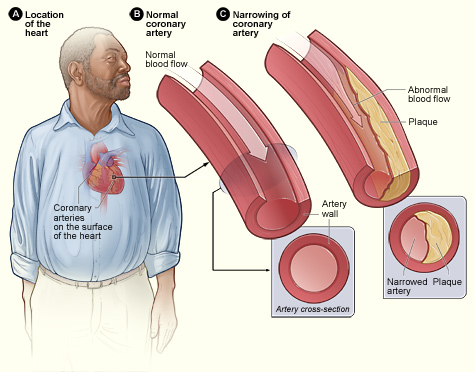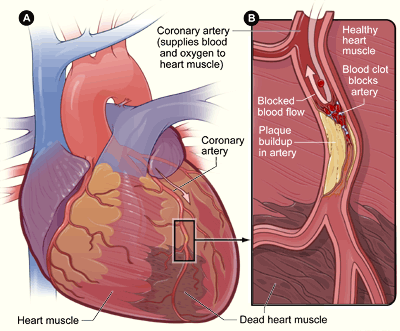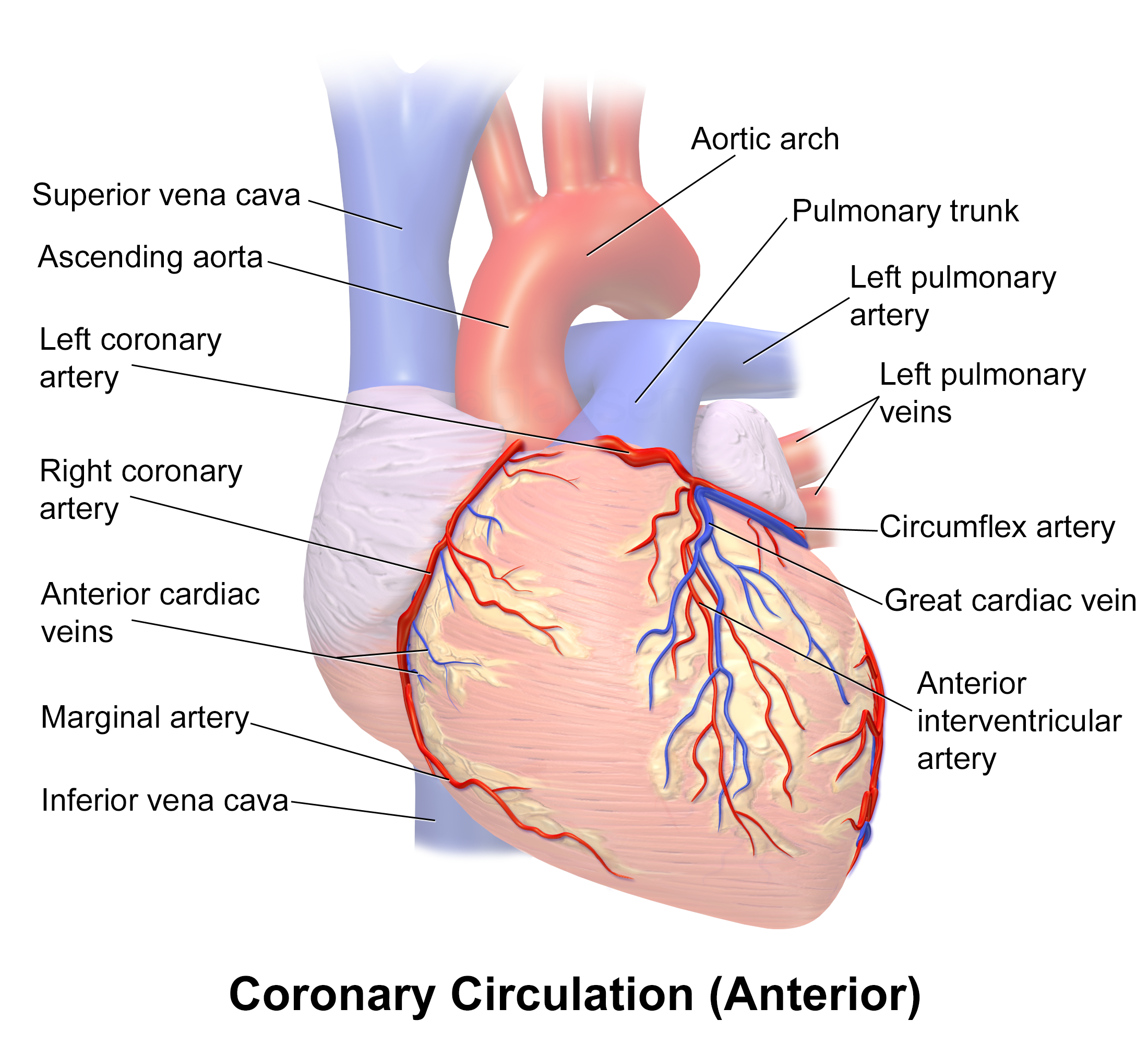Coronary Arteries on:
[Wikipedia]
[Google]
[Amazon]
The coronary arteries are the arterial blood vessels of

 Narrowing of the arteries can be caused by a process known as
Narrowing of the arteries can be caused by a process known as  A
A


coronary circulation
Coronary circulation is the Circulatory system#Coronary vessels, circulation of blood in the arteries and veins that supply the cardiac muscle, heart muscle (myocardium).
Coronary arteries supply oxygen saturation (medicine), oxygenated blood to ...
, which transport oxygenated blood
Blood is a body fluid in the circulatory system of humans and other vertebrates that delivers necessary substances such as nutrients and oxygen to the Cell (biology), cells, and transports Metabolic waste, metabolic waste products away from th ...
to the heart muscle. The heart
The heart is a muscular Organ (biology), organ found in humans and other animals. This organ pumps blood through the blood vessels. The heart and blood vessels together make the circulatory system. The pumped blood carries oxygen and nutrie ...
requires a continuous supply of oxygen to function and survive, much like any other tissue or organ of the body.
The coronary arteries wrap around the entire heart. The two main branches are the left coronary artery and right coronary artery
In the coronary circulation, blood supply of the heart, the right coronary artery (RCA) is an artery originating above the right cusp of the aortic valve, at the Aortic sinus, right aortic sinus in the heart. It travels down the right coronary su ...
. The arteries can additionally be categorized based on the area of the heart for which they provide circulation. These categories are called ''epicardial'' (above the epicardium, or the outermost tissue of the heart) and ''microvascular'' (close to the endocardium
The endocardium (: endocardia) is the innermost layer of tissue that lines the chambers of the heart. Its cells are embryologically and biologically similar to the endothelial cells that line blood vessels. The endocardium also provides prot ...
, or the innermost tissue of the heart).
Reduced function of the coronary arteries can lead to decreased flow of oxygen and nutrients to the heart. Not only does this affect supply to the heart muscle itself, but it also can affect the ability of the heart to pump blood throughout the body. Therefore, any disorder or disease of the coronary arteries can have a serious impact on health, possibly leading to angina
Angina, also known as angina pectoris, is chest pain or pressure, usually caused by insufficient blood flow to the heart muscle (myocardium). It is most commonly a symptom of coronary artery disease.
Angina is typically the result of parti ...
, a heart attack
A myocardial infarction (MI), commonly known as a heart attack, occurs when Ischemia, blood flow decreases or stops in one of the coronary arteries of the heart, causing infarction (tissue death) to the heart muscle. The most common symptom ...
, and even death.
Structure
The coronary arteries are mainly composed of the left and right coronary arteries, both of which give off several branches, as shown in the 'coronary artery flow' figure. *
Aorta
The aorta ( ; : aortas or aortae) is the main and largest artery in the human body, originating from the Ventricle (heart), left ventricle of the heart, branching upwards immediately after, and extending down to the abdomen, where it splits at ...
** Left coronary artery
*** Left anterior descending artery
*** Left circumflex artery
*** Posterior descending artery
***Ramus or intermediate artery
**Right coronary artery
In the coronary circulation, blood supply of the heart, the right coronary artery (RCA) is an artery originating above the right cusp of the aortic valve, at the Aortic sinus, right aortic sinus in the heart. It travels down the right coronary su ...
*** Right marginal artery
*** Posterior descending artery
The left coronary artery arises from the aorta
The aorta ( ; : aortas or aortae) is the main and largest artery in the human body, originating from the Ventricle (heart), left ventricle of the heart, branching upwards immediately after, and extending down to the abdomen, where it splits at ...
within the left cusp of the aortic valve
The aortic valve is a valve in the heart of humans and most other animals, located between the left ventricle and the aorta. It is one of the four valves of the heart and one of the two semilunar valves, the other being the pulmonary valve. ...
and feeds blood to the left side of the heart
The heart is a muscular Organ (biology), organ found in humans and other animals. This organ pumps blood through the blood vessels. The heart and blood vessels together make the circulatory system. The pumped blood carries oxygen and nutrie ...
. It branches into two arteries, the left anterior descending and the left circumflex. The left anterior descending artery perfuses the interventricular septum
The interventricular septum (IVS, or ventricular septum, or during development septum inferius) is the stout wall separating the ventricle (heart), ventricles, the lower chambers of the heart, from one another.
The interventricular septum is di ...
and anterior wall of the left ventricle
A ventricle is one of two large chambers located toward the bottom of the heart that collect and expel blood towards the peripheral beds within the body and lungs. The blood pumped by a ventricle is supplied by an atrium, an adjacent chamber in t ...
. The left circumflex artery perfuses the left ventricular free wall. In approximately 33% of individuals, the left coronary artery gives rise to the posterior descending artery which perfuses the posterior and inferior walls of the left ventricle. Sometimes a third branch is formed at the fork between left anterior descending and left circumflex arteries, known as a ''ramus'' or ''intermediate artery''.
The right coronary artery
In the coronary circulation, blood supply of the heart, the right coronary artery (RCA) is an artery originating above the right cusp of the aortic valve, at the Aortic sinus, right aortic sinus in the heart. It travels down the right coronary su ...
(RCA) originates within the right cusp of the aortic valve. It travels down the right coronary sulcus
The coronary sulcus (also called coronary groove, auriculoventricular groove, atrioventricular groove, AV groove) is a Sulcus (morphology), groove on the surface of the heart at the base of right auricle that separates the Atrium (heart), atria fr ...
, towards the crux of the heart. The RCA primarily branches into the right marginal arteries, and, in 67% of individuals, gives place to the posterior descending artery. The right marginal arteries perfuse the right ventricle and the posterior descending artery perfuses the left ventricular posterior and inferior walls.
There is also the conus artery, which is only present in about 45 percent of the human population, and which provides collateral blood flow to the heart when the left anterior descending artery is occluded.
Clinical significance
 Narrowing of the arteries can be caused by a process known as
Narrowing of the arteries can be caused by a process known as atherosclerosis
Atherosclerosis is a pattern of the disease arteriosclerosis, characterized by development of abnormalities called lesions in walls of arteries. This is a chronic inflammatory disease involving many different cell types and is driven by eleva ...
(most common), arteriosclerosis
Arteriosclerosis, literally meaning "hardening of the arteries", is an umbrella term for a vascular disorder characterized by abnormal thickening, hardening, and loss of elasticity of the walls of arteries; this process gradually restricts th ...
, or arteriolosclerosis. This occurs when plaques (made up of deposits of cholesterol
Cholesterol is the principal sterol of all higher animals, distributed in body Tissue (biology), tissues, especially the brain and spinal cord, and in Animal fat, animal fats and oils.
Cholesterol is biosynthesis, biosynthesized by all anima ...
and other substances) build up over time in the walls of the arteries. Coronary artery disease
Coronary artery disease (CAD), also called coronary heart disease (CHD), or ischemic heart disease (IHD), is a type of cardiovascular disease, heart disease involving Ischemia, the reduction of blood flow to the cardiac muscle due to a build-up ...
(CAD) or ischemic heart disease are the terms used to describe narrowing of the coronary arteries.
As the disease progresses, plaque buildup can partially block blood flow to the heart muscle. Without enough blood supply (ischemia
Ischemia or ischaemia is a restriction in blood supply to any tissue, muscle group, or organ of the body, causing a shortage of oxygen that is needed for cellular metabolism (to keep tissue alive). Ischemia is generally caused by problems ...
), the heart is unable to work properly, especially under increased stress. Stable angina is chest pain on exertion that improves with rest. Unstable angina
In dynamical systems instability means that some of the outputs or internal states increase with time, without bounds. Not all systems that are not stable are unstable; systems can also be marginally stable or exhibit limit cycle behavior ...
is chest pain that can occur at rest, feels more severe, and/or last longer than stable angina. It is caused by more severe narrowing of the arteries.
 A
A heart attack
A myocardial infarction (MI), commonly known as a heart attack, occurs when Ischemia, blood flow decreases or stops in one of the coronary arteries of the heart, causing infarction (tissue death) to the heart muscle. The most common symptom ...
results from a sudden plaque rupture and formation of a thrombus
A thrombus ( thrombi) is a solid or semisolid aggregate from constituents of the blood (platelets, fibrin, red blood cells, white blood cells) within the circulatory system during life. A blood clot is the final product of the blood coagulatio ...
(blood clot) that completely blocks blood flow to a portion of the heart, leading to tissue death ( infarct).
CAD can also result in heart failure
Heart failure (HF), also known as congestive heart failure (CHF), is a syndrome caused by an impairment in the heart's ability to Cardiac cycle, fill with and pump blood.
Although symptoms vary based on which side of the heart is affected, HF ...
or arrhythmias
Arrhythmias, also known as cardiac arrhythmias, are irregularities in the heartbeat, including when it is too fast or too slow. Essentially, this is anything but normal sinus rhythm. A resting heart rate that is too fast – above 100 beats ...
. Heart failure is caused by chronic oxygen deprivation due to reduced blood flow, which weakens the heart over time. Arrhythmias are caused by inadequate blood supply to the heart that interferes with the heart's electric impulse.
The coronary arteries can constrict as a response to various stimuli, mostly chemical. This is known as a coronary reflex Coronary reflex is the change of coronary diameter in response to chemical, neurological or mechanical stimulation of the coronary arteries.
The coronary reflexes are stimulated differently from the rest of the Circulatory system, vascular system.
...
.
There is also a rare condition known as spontaneous coronary artery dissection, in which the wall of one of the coronary arteries tears, causing severe pain. Unlike CAD, spontaneous coronary artery dissection is not due to plaque buildup in arteries, and tends to occur in younger individuals, including women who have recently given birth or men who do intense exercise.
Coronary artery dominance is described as the coronary artery that give branches to supply the right posterior descending artery and supplies the inferior wall of the heart. In 80 to 85% of the population, the right coronary artery supplies the posterior descending artery, making it right heart dominant while in 7 to 13% of the population, the left coronary artery supplies the posterior descending artery, making it left heart dominant. In 7 to 8% of the population, both right and left coronary arteries supplies the posterior descending artery, making it right and left co-dominance. Narrowing of coronary arteries is more frequent in those who are left dominant when compared to those who have right dominant or co-dominant hearts.
Name etymology
The word ' is aLatin
Latin ( or ) is a classical language belonging to the Italic languages, Italic branch of the Indo-European languages. Latin was originally spoken by the Latins (Italic tribe), Latins in Latium (now known as Lazio), the lower Tiber area aroun ...
word that means "crown", from the Ancient Greek
Ancient Greek (, ; ) includes the forms of the Greek language used in ancient Greece and the classical antiquity, ancient world from around 1500 BC to 300 BC. It is often roughly divided into the following periods: Mycenaean Greek (), Greek ...
(, "garland, wreath"). It was applied to the coronary arteries because of a notional resemblance (compare the photos).
The word ''arterie'' in Anglo-French (' in Old French
Old French (, , ; ) was the language spoken in most of the northern half of France approximately between the late 8th [2-4; we might wonder whether there's a point at which it's appropriate to talk of the beginnings of French, that is, when it wa ...
, and ' in Latin) means "windpipe" and "an artery". It was applied to the coronary arteries because the arteries do not contain blood after death.
See also
* Coronary circulation * Left coronary artery *Right coronary artery
In the coronary circulation, blood supply of the heart, the right coronary artery (RCA) is an artery originating above the right cusp of the aortic valve, at the Aortic sinus, right aortic sinus in the heart. It travels down the right coronary su ...
* Heart
The heart is a muscular Organ (biology), organ found in humans and other animals. This organ pumps blood through the blood vessels. The heart and blood vessels together make the circulatory system. The pumped blood carries oxygen and nutrie ...
* Cardiology
Cardiology () is the study of the heart. Cardiology is a branch of medicine that deals with disorders of the heart and the cardiovascular system. The field includes medical diagnosis and treatment of congenital heart defects, coronary artery di ...
* Coronary artery disease
Coronary artery disease (CAD), also called coronary heart disease (CHD), or ischemic heart disease (IHD), is a type of cardiovascular disease, heart disease involving Ischemia, the reduction of blood flow to the cardiac muscle due to a build-up ...
* Angina
Angina, also known as angina pectoris, is chest pain or pressure, usually caused by insufficient blood flow to the heart muscle (myocardium). It is most commonly a symptom of coronary artery disease.
Angina is typically the result of parti ...
* Unstable angina
In dynamical systems instability means that some of the outputs or internal states increase with time, without bounds. Not all systems that are not stable are unstable; systems can also be marginally stable or exhibit limit cycle behavior ...
* Heart attack
A myocardial infarction (MI), commonly known as a heart attack, occurs when Ischemia, blood flow decreases or stops in one of the coronary arteries of the heart, causing infarction (tissue death) to the heart muscle. The most common symptom ...
* Cardiac skeleton
* Coronary sinus
The coronary sinus () is the largest vein of the heart. It drains over half of the deoxygenated blood from the heart muscle into the right atrium. It begins on the backside of the heart, in between the left atrium, and left ventricle; it begi ...
* Foramen ovale (heart)
In the fetal heart, the foramen ovale (), also foramen Botalli or the ostium secundum of Born, allows blood to enter the left atrium from the right atrium. It is one of two fetal cardiac shunts, the other being the ductus arteriosus (which allo ...
* Patent foramen ovale
Additional images


References
{{Authority control Anatomy Cardiac anatomy